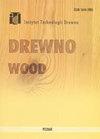薄木件干燥过程中数据的采集和统计分析方法
IF 0.9
4区 农林科学
Q3 MATERIALS SCIENCE, PAPER & WOOD
引用次数: 2
摘要
本文提出了一种原始的方法,从干燥薄木制品的过程中获取和统计分析数据,而不干扰制造计划或过程。该研究旨在减少在对流干燥室中薄片干燥过程的持续时间,并最大限度地减少干燥薄片的不一致性。作者讨论了对流干燥方法的有效应用,考虑到由于不均匀或不充分暴露于干燥剂而导致的过度干燥或欠干燥导致的木材质量不均匀,干燥过程的持续时间长,以尽量减少材料的内应力,干燥过程的效率低,以及相对较高的操作成本。根据所进行的试验,建议采用快速干燥方案。为了减少不合格片层的比例,作者建议改变片层在笼中的排列,使所有片层都受到保护,以防止无约束变形。本文章由计算机程序翻译,如有差异,请以英文原文为准。
The methodology of acquisition and statistical analysis of data from the process of drying thin wooden elements
This paper presents an original methodology of acquisition and statistical analysis of data from the process of drying thin wooden items, without interference in the manufacturing schedule or process. The research was aimed at reducing the duration of the lamella drying process in a convectional drying chamber, and minimising non-conformities of dry lamellas. The authors discuss the effective application of convectional drying methods, taking into consideration non-homogeneous wood quality resulting from overor under-drying caused by uneven or insufficient exposure to the drying agent, long duration of the drying process serving to minimise the internal stress of the material, poor efficiency of the drying process, and relatively high operational costs. Based on the tests performed, a quick drying programme is recommended. To reduce the fraction of non-conforming lamellas, the authors suggest that the arrangement of lamellas in the cage be changed so that all lamellas are protected against unconstrained deformation.
求助全文
通过发布文献求助,成功后即可免费获取论文全文。
去求助
来源期刊

Drewno
MATERIALS SCIENCE, PAPER & WOOD-
CiteScore
1.10
自引率
12.50%
发文量
0
审稿时长
>12 weeks
期刊介绍:
Wood. Research papers. Reports. Announcements" ("Drewno") is an international scientific journal that publishes original results of innovatory basic and applied research concerning technological, technical, economic and ecological issues important for the wood science and forest-based industries, including their environment, and interesting to the international recipients. "Drewno" is an Open Access biannual journal.
Aims and scope:
wood science: anatomy, biology, chemistry, physics
wood mechanical and chemical technology, inter alia, sawmilling, composite wood products, wooden construction, furniture making, wood pulp, paper making
material engineering, biocomposites, nanocomposites
material management
environmental protection, safety of the processes, products and working stations
biotechnology
bioenergy, biofuels
forestry: harvesting and wood quality
wood-based industries economics
The Editorial Board of the journal especially welcomes articles concerning increase in wood resources (wood mobilisation); innovative composites and lignocellulosic materials; new trends in the protection, modification and finishing of wood; biorefining of raw wood material; "green" building; new technologies of wood waste recycling; sustainable development; innovation management; and business networks.
 求助内容:
求助内容: 应助结果提醒方式:
应助结果提醒方式:


